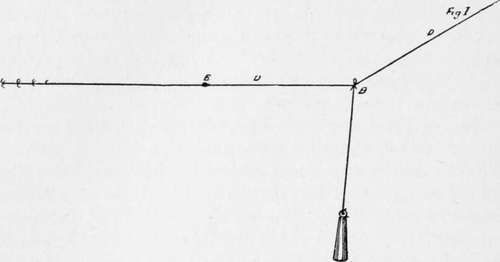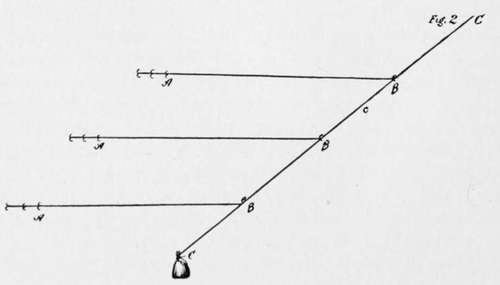The Lake Trout. Part 4
Description
This section is from the book "American Game Fishes", by W. A. Perry. Also available from Amazon: American Game Fishes: Their Habits, Habitat, and Peculiarities; How, When, and Where to Angle for Them.
The Lake Trout. Part 4
The following are the dimensions of the "Seth Green Gang," as illustrated in the cut. The hooks are number 8, forged O'shaughnessy. From the bend of the lower treble hook, A, to the bend of the treble hook B, one and one-quarter inches; from the bend of the treble hook B, to the bend of the double hook, C, two inches. The double hook is made of a number 8 and a number 6, the latter for putting through the head of the bait. From the double hook, C, to the swivel, D, two and a quarter inches; swivel, one-half inch, making a total of six inches. The hooks are whipped on with waxed silk, and the gut is double between the double hook and the swivel.
Mr. Cheney's method is as follows:

A. N. Cheney's Gang For Trolling.
"The tackle for deep trolling consists of a stiff rod about ten feet long, in three joints, with double standing guides on second joint and tip, so that as the rod becomes bent from the heavy strain, the upper joints can be turned to present the opposite side to the pressure. A multiplying reel to hold 150 yards of number 4 or 5 braided silk or linen line; single leaders of best silk-worm gut, from nine to twelve feet long, with two swivels tied midway in them. (I use what I call a swivel line, made of five box-swivels, number eight, fastened together by bits of fish-line nicely whipped with waxed silk, and this I use to connect the reel or hand-line with the leader.) The swivels will be found very necessary to keep your rod-line from twisting. A drop of porpoise oil will increase their freedom of action. Lead sinkers from two to sixteen ounces in weight are needed for deep-water trolling.
"For surface trolling, or when a very light sinker is used, any light bait rod will answer the purpose.
"The last of the tackle to mention is what is fastened to the end of the line-the minnow gang. The treble hooks for the gangs are made by soldering three first quality O'shaughnessy hooks together, back to back.
"The gang, as illustrated above, is such as I make and use for my own fishing. I make them of different sizes, i. c, of different distances between the hooks, and of different sized hooks, from number 10 up to number 5. I do this to be provided for different sized bait-fish. I use the whole gut length, of round, smooth, cream-colored gut, with the superfluous ends cut off, and the measurements of the one in the cut are as follows:
UA to B, one and one-eighth inches; B to C, one and one-quarter inches; C to D, a single lip-hook, one and three-eighths inches; D to E, five and one-half inches. The treble hooks are number 8, and the lip-hook number 6, all round-wire O'shaughnessy's.
"An excellent lip-hook for the latter gang is made so that it will move on the gut, thus enabling the angler to fit minnows of various sizes to one gang. The hook is fashioned by soldering two small loops of brass wire to the back of the shank of the lip hook, one at the extreme end, the other where the hook begins to bend sharply. Or, what is better, make the loops by whipping on to the hook's shank a piece of doubled gut, the two ends of the gut coming together under the whipping. Before the swivel is fastened on, put the end of the gang gut through the lower loop, then around the shank of the hook, and then through the other loop. The lip-hook will move up and down on the gut. Always soak the gut before moving the hook.
"The bait is fastened on by first killing the minnow, or golden shiner, and putting the lip-hook through both lips of the minnow; then bend the bait and put one of the treble hooks into the back of the fish near the dorsal, and another near the caudal. A Trout almost always strikes a fish toward the tail. The baited gang should revolve slowly, with a motion as though the minnows were crippled. Practice will teach one the proper bend to produce the proper motion.
"The bait most generally used, and considered the best, is the golden shiner, or bream, particularly for deep trolling, as its burnished scales can be seen for a great distance in clear water. For surface trolling, suckers, chubs, dace, and anything that comes to your net in the shape of minnows, will answer for baiting the gang. Where bait is scarce, it is well to bind the minnow to the gang, with a few turns of strong white or lead-colored linen or cotton thread.


Gear For Deep Trolling.
"Figure I shows the lower end of a rod or hand-line, as it is supposed to be in the water. The gang A is fastened to the leader at C; at E the leader is attached to the reel, or hand-line D D: at R a cone-shaDed sinker is fastened to the reel or hand-line by a half hitch of the sinker-line, which is about three feet long, and of weaker material than the reel-line. So, if the sinker gets fast, and something must be broken, you will lose only the sinker. From A to B there should be a distance of about twenty-five feet. If the swivel-line is used, it should connect the leader and reel-line.
"Figure 2 shows Seth Green's hand-line, sinker, and three gangs. The sinker is fastened to the end of the hand-line, C C. The line, as I remember it, is about the size of a hard braided linen line, number o. The gangs and leaders, A B, twelve feet long, are fastened to the hand-line one above the other. To use Seth Green's own words:
"'The first leader is usually about three feet from the sinker, and the others vary from eight to twelve feet apart, according to where the fish are. If I do not catch them fishing low, I raise the leaders, that is the two upper ones, but leave the lower one the same.'
"The line with the single gang has the sinker fastened with a half-hitch, so it can easily be taken off, for it is not desirable to take the sinker into the boat when it is fast to the line, as a run on the part of the fish might find the angler unprepared to put the sinker overboard at the right moment. In the spring, when the Trout are at or near the surface, little or no sinker is required.
Continue to:
